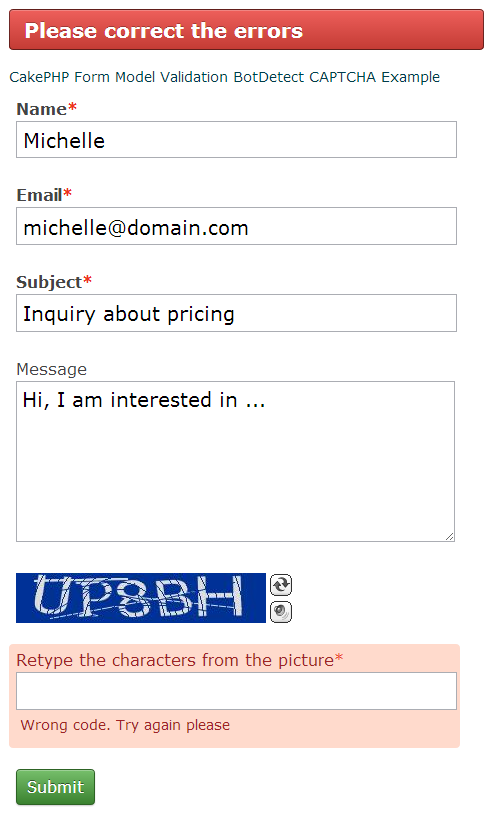CakePHP 2.6 Form Model Validation BotDetect CAPTCHA Example (BotDetect v3.0; deprecated)
This code example shows how to integrate FormHelper and Model validation, which provide a lot of out-the-box functionality when used together.
First Time Here?
Check the BotDetect CakePHP 2.6 Captcha Quickstart for key integration steps.
The example is based around a contact form which sends email if the user input is considered valid – a likely real world scenario for Captcha protection integration.
To keep the example brief, it doesn't use a database backend. Still, this type of Model integration is ideal for protecting database-driven forms that take advantage of the CakePHP Model infrastructure.

Files for this ('bd-captcha-cakephp-2.6-examples') example:
The files are available for download as a part of the BotDetect Captcha CakePHP integration package.
View – /app/View/Contact/index.ctp
<h1>CakePHP Form Model Validation BotDetect CAPTCHA Example</h1> <?php // include the BotDetect layout stylesheet $this->Html->css(CaptchaUrls::LayoutStylesheetUrl(), array('inline' => false)); echo $this->Form->create(null, array('url' => array('controller' => 'contact', 'action' => 'index'))); echo $this->Form->input('name'); echo $this->Form->input('email'); echo $this->Form->input('subject'); echo $this->Form->input('message'); // Captcha is only shown if not already solved if (!is_null($captchaHtml)) { // display Captcha markup, wrapped in an extra div for layout purposes echo $this->Html->div('captcha', $captchaHtml, false); // Captcha code user input textbox echo $this->Form->input('CaptchaCode', array( 'label' => 'Retype the characters from the picture:', 'maxlength' => '10' ) ); } echo $this->Form->submit(); echo $this->Form->end(); ?>
The View part of this example is straightforward. The FormHelper creates input fields of proper type and length in conjuction with the Model. Our Captcha Html is placed above the form field designated for retyping in the characters from the Captcha image, and only shown if the user hasn't already solved the Captcha challenge.
Model – /app/Model/Contact.php
<?php class Contact extends AppModel { public $name = 'Contact'; public $useTable = false; // a public field for Captcha validation status, adjusted by Controller code public $isCaptchaValid = false; public $validate = array( 'name' => array( 'rule' => '/.+/', 'allowEmpty' => false, 'required' => true, ), 'subject' => array( 'rule' => array('minLength', 10), 'message' => 'Please enter at least 10 characters' ), 'email' => array( 'rule' => 'email', 'message' => 'Please type your email address correctly' ), // Captcha code user input validation rules 'CaptchaCode' => array( 'rule' => 'checkIsCaptchaValid', 'message' => 'Please retype the characters from the picture' ) ); // simply return the Captcha validation status function checkIsCaptchaValid() { return $this->isCaptchaValid; } function schema($field = false) { return array ( 'name' => array('type' => 'string', 'length' => 64), 'email' => array('type' => 'string', 'length' => 64), 'message' => array('type' => 'text', 'length' => 256), 'subject' => array('type' => 'string', 'length' => 128), ); } } ?>
The Model implements a custom rule for the CaptchaCode field and bridges the validation state from the Controler via the $isCaptchaValid public class property. This property is modified in Controller code where the Captcha component is available for use.
Controller – /app/Controller/ContactController.php
<?php class ContactController extends AppController { public $name = 'Contact'; public $uses = 'Contact'; public $helpers = array('Html', 'Form', 'Js'); public $components = array( 'Email', 'Session', // load the BotDetect Captcha component along with the other ones and set its parameters 'BotDetect.Captcha' => array( 'CaptchaId' => 'ContactCaptcha', // a unique Id for the Captcha instance 'UserInputId' => 'ContactCaptchaCode' // Id of the Captcha code input textbox ) ); public function index() { if ($this->request->is('post')) { // Captcha is only validated if not already solved if (!$this->Captcha->IsSolved) { // validate the user-entered Captcha code and adjust Model validity $this->Contact->isCaptchaValid = $this->Captcha->Validate($this->request->data[ 'Contact']['CaptchaCode']); } else { $this->Contact->isCaptchaValid = true; } $this->Contact->set($this->request->data); // clear previous user input, since each Captcha code can only be validated once unset($this->request->data['Contact']['CaptchaCode']); if ($this->Contact->validates()) { // reset Captcha status after each sent email, since we don't want the user to // be able to send an unlimited number of emails after solving the Captcha once $this->Captcha->Reset(); // TODO: send email $this->redirect(array('action' => 'index')); } else { $this->Session->setFlash('Please correct the errors'); } } // make Captcha Html accessible to View code if (!$this->Captcha->IsSolved) { $this->set('captchaHtml', $this->Captcha->Html()); } else { $this->set('captchaHtml', null); } } }
The Controller part of the example provides the necessary helpers and data for the View to use, adding Captcha validation functionality as outlined in the BotDetect CakePHP 2.6 integration guide.
After loading the component and setting the Captcha markup required for the View display, the $this->request variable is checked to see if the form was submitted or not. The form data is encapsulated in the Contact array which coresponds with the Model used by the Controller, and which the FormHelper creates automatically. The user-entered Captcha code coresponds to the CaptchaCode field inside that array.
After supplying the Captcha component with the correct data to validate, we want to pass the Captcha validation result to our Model, before starting the validation of model state itself.
Notice that the code proceeds to send the email only if the whole Model state validates, which includes the Captcha validation result we provided from outside of the model.
We also take advantage of the Captcha object's IsSolved property to correctly handle the case when the user retypes the Captcha code correctly but other field validation fails, as explained here.
Please Note
The information on this page is out of date and applies to a deprecated version of BotDetect™ CAPTCHA (v3.0).
An up-to-date equivalent page for the latest BotDetect Captcha release (v4) is BotDetect v4 Captcha documentation index.
General information about the major improvements in the current BotDetect release can be found at the What's New in BotDetect v4.0 page.
Current BotDetect Versions
-
BotDetect ASP.NET CAPTCHA
2019-07-22v4.4.2 -
BotDetect Java CAPTCHA
2019-07-22v4.0.Beta3.7 -
BotDetect PHP CAPTCHA
2019-07-22v4.2.5












